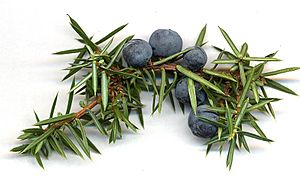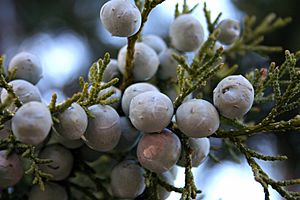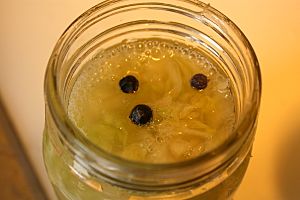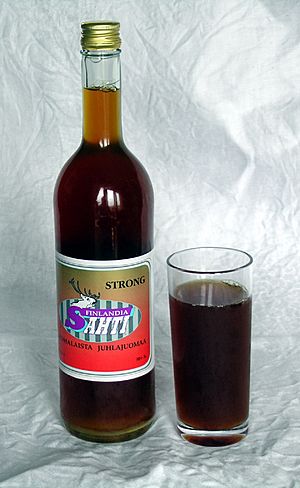Juniper berry facts for kids

A juniper berry is not a real berry! It's actually a special type of conifer cone that looks like a berry. These cones grow on different kinds of juniper plants. They have soft, joined scales that make them look like a small fruit.
The cones from some juniper types, especially the common juniper, are used as a spice. People use them a lot in European cuisine. Juniper berries also give gin its special taste. They might be the only spice that comes from conifer trees!
Contents
What Are Juniper Berries Used For?
When juniper berries are young and green, they taste a bit like pinene, which is found in pine trees. As they get older, this piney taste mixes with fresh, citrusy flavors. The outside of the berries doesn't have much flavor. So, people usually crush them a little before using them as a spice.
You can use juniper berries fresh or dried. But they taste and smell strongest right after they are picked. Their flavor gets weaker as they dry and are stored.
Juniper Berries in Cooking
Juniper berries are popular in northern European cooking, especially in places like Norway and Sweden. They add a sharp, clear flavor to meat dishes. They are often used with wild birds and game meats, like boar and venison. They also taste great with pork, cabbage, and sauerkraut.
A traditional dish from Alsace called choucroute garnie always includes juniper berries. This dish is made with sauerkraut and different meats. Besides Norwegian and Swedish dishes, juniper berries are also used in German, Austrian, Czech, Polish, and Hungarian cooking. They are often added to roasts, like German sauerbraten. In Northern Italy, especially in the South Tyrol region, juniper berries are also a common ingredient.
Juniper Berries in Drinks
Juniper berries, usually from the common juniper plant, are used to flavor gin. Gin is a type of drink that was first made in the Netherlands in the 1600s. The name gin comes from the French word genièvre or the Dutch word jenever, both of which mean "juniper."
Other drinks also use juniper for flavor. For example, sahti is a Finnish rye beer that gets its taste from both juniper berries and branches. There's also a soft drink called Julmust made in Sweden. It's mostly sold around Christmas time and uses juniper berries for flavor. Some companies even make juniper-berry soda!
Other Uses for Juniper Berries
Some types of juniper in North America have sweeter, less resinous berries. These berries were used by some Native American groups not just for seasoning food, but also as a nutritious food source. Besides cooking and traditional medicine, Native Americans also used the seeds from juniper berries to make jewellery and decorations.
An essential oil taken from juniper berries is used in aromatherapy. This is a way to use plant oils for well-being. It's also used to make perfumes.
Images for kids
-
Juniper berries are actually modified conifer cones.
-
Dried juniper berries at a market in Syracuse, Sicily







